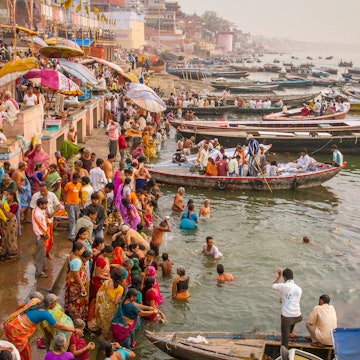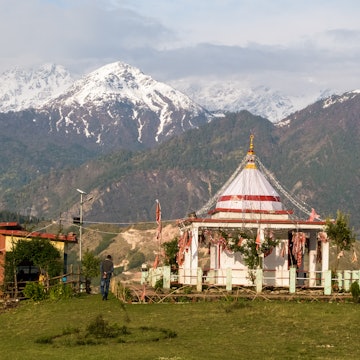

The author and his Royal Enfield Himalayan motorcycle in Goa, India. Ian Neubauer for Lonely Planet
When it comes to bucket lists, few destinations hold a candle to India. Rife with palaces and temples, world-class beach resorts, the world’s tallest mountain range, 43 UNESCO World Heritage-listed sites and more safari options than any country outside Africa, India is a deeply emotive and spiritual country, one that tends to get under your skin. It’s also considered to be a budget destination.
I am a freelance moto-journalist with more than 20 years' experience writing and producing adventure stories and reviewing motorbikes around the world. I have ridden motorcycles through different parts of India three times, with my most recent visit in March 2025, when I spent a month riding through south India. These are my top tips for a successful and safe motorbike experience in India.

Why travel India by motorcycle?
Getting around India can be a challenge. The nation’s railways offer nostalgia and adventure but can’t take you everywhere and first-class seats and sleepers are often sold out far in advance. Tourists have to rely on India’s fleets of antiquated buses, and negotiate with rickshaw drivers who may employ tricks and cons to charge an inflated rate.
The only way of getting around India in relative comfort and style is on domestic flights or self-drive vacations. And while a car will see you stuck in endless traffic, motorbikes offer a fast, convenient and relatively affordable solution as well as a more intimate connection with the landscape and locals.
How do I choose the right kind of motorbike for India?
India is a special case in the motorcycling world as it’s the home of Royal Enfield Motors. A 124-year-old marque that produced motorcycles for the British military in both World Wars, today it makes two practical and affordable models: the Bullet 350, an indestructible vintage-style roadster that starts from US$2050 brand-new or can be rented directly from the manufacturer in many Indian cities for US$19 per day; and the Himalayan 450, a mid-size ADV (adventure motorcycle) developed to keep riders comfortable on long rides with both on- and off-road touring in mind. A new Himalayan costs US$3380 in India or $23 per day to rent.
KTM, an Austrian brand with a cult global following, also manufactures inexpensive mid-size ADVs in India: the KTM 250 Adventure and the KTM 390 Adventure R, which cost US$3000 and US$4700, respectively, or you can rent one through KTM India’s touring partners. I own a KTM and am a huge fan. They accelerate, lean and brake like demons and are a lot of fun. They are better on paved roads than Enfields, but can be unreliable and tend to break down. Enfields used to be terribly unreliable in the past but every motorbike they have made in the last five years has been solid. For these reasons, your best bet when biking in India is a Royal Enfield Himalayan.

What are the best routes for motorbiking in India?
If it’s mountains you want to see, the Himalayas in the north is the obvious answer. The most popular route heads north out of New Delhi into the Himalayan states of Himachal Pradesh, Jammu and Kashmir, and Ladakh, home to Umling La Pass, which at 5790m (18,996ft) is the highest motorable pass in the world.
On the other side of the country, the eight states of northeast India offer more remote and challenging riding, and an opportunity to visit with the (now retired) headhunters of Nagaland. Another popular route takes riders through Rajasthan in the geographic heart of India, oscillating between cities like Jaipur and Agra and their magnificent forts and ancient palaces. India’s south also offers a treasure trove of Hindu temples and historical sites in addition to the beaches of Goa, the fascinating backwaters of Kerala and the hill stations of Tamil Nadu.
When is the best time to ride through India?
The winter, from mid-November to February, is the only good time to ride in south India. By March the heat becomes intolerable and the air feels like hot gas. Winter is also the best time to ride in Rajasthan, which is 60% desert. Ride the Himalayas in March, April and May. June to September is the monsoon season in India when many regions see heavy rainfall, particularly in the Himalayas.

What gear is essential?
If you’re riding in south or central India you can get away with the basics: riding pants with Kevlar lining that cannot be torn, a pair of summer riding gloves made of leather, a light and breathable motorbike jacket plus plenty of sunscreen.
If you head into Rajasthan during the winter or the Himalayas at any time of the year, you will need a more complicated and expensive winter kit. This includes a good pair of riding pants and a matching jacket by a company like Dririder that has at least two layers: a thick outer layer and a removable inner raincoat and rain pants. Thermal undergarments are a must, as are long woollen socks, a scarf, a balaclava and a pair of thick winter gloves plus glove liners.
No matter where you ride, you’ll also need a full-face helmet, preferably with a built-in sun visor, and a solid pair of steel-capped boots.
What is the best way to carry luggage on a motorcycle?
Take it from me; the best solution by far are panniers – two evenly weighted containers slung over the back seat or clipped onto the side of your motorbike’s frame. Canvas panniers are cheap but they won’t last more than a few weeks before they start to tear, while metal panniers tend to get dented and break easily. I have found that flexible plastic panniers by a company like Shad are the best option.
Top boxes offer extra storage space while attachable tank bags are handy for storing bits and bobs. Most rented motorbikes do not come with panniers, which means you have to buy a pair. The only option is to tie your backpack to the luggage rack on your motorbike, if it even has one, using octopus straps, and hope that it doesn’t fall off without you noticing. You can also carry stuff on your back, but the more weight on your body, the more you will suffer, especially on long rides.

What permits do you need?
Surprisingly very little is required. All you need is an international drivers license that shows you are licensed to ride a motorbike of any capacity and a tourist visa like everyone else. To visit Nagaland, Sikkim and other politically sensitive areas in northeast India, you need to apply for specific Inner Line Permits.
How much is this going to cost?
Put aside around US$500–700 per month to rent an ADV in India. Fuel costs about US$1.20 per liter, so factor in another US$10–15 for a full day’s riding. At a minimum, you will need to invest several hundred dollars for good-quality summer riding gear and US$1000 for a winter kit. You can buy a quality full-face helmet in India for around US$100 though they cost many times that in the West.
An international driver’s license will set you back US$20–50, depending on your country of residence. During my trip to India this year, I found clean, decent hotels for as little as US$20 per night. Food only cost me about US$5 per day when I ate locally. Western meals at more modern restaurants start at US$5.

Is it safe to ride a motorbike in India?
It’s really, really dangerous. According to India’s Ministry of Road Transport and Highways, road accidents claim at least 178,000 lives each year in India, more than any other country, with two-wheeler deaths accounting for a whopping 44% of fatalities. Other road users plays a part in this but so do the bad road conditions.
There are now thousands of kilometers of modern four-lane carriageways in India but 70–80% of the riding I did in India this year was on broken, potholed, badly maintained two-lane roads. Speed bumps – of which there are millions in India – are generally unsigned and gave me mini-heart attacks every time I hit one without warning. There are also millions of steel barricades erected at zebra crossings to stop speeding drivers from mowing pedestrians down but which become camouflaged in the searing heat and are very dangerous for riders.
But the biggest threat comes from other drivers who can be undisciplined. They generally do not indicate, swerve between lanes and overtake on a whim. If a truck or bus comes charging towards you, eating up your lane, you better get out of the way fast. Many drivers seem unconcerned about the possibility of running other road users off the road. Cows, which loiter on roads throughout India, will kill you if you hit one at speed, and you need to keep an eye out for wildlife, including elephants, deer, monkeys and large birds of prey.
I have survived three tours in India without a scratch by riding extra defensively. I expect every other rider, driver, pedestrian and animal on the road to do the stupidest and most dangerous thing they could possibly do. That way, if they do it, I see it coming and have time to take defensive action. I also never ride at night and always try to avoid riding at dusk when the light is low.
















